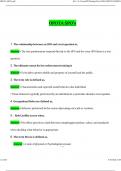Exam (elaborations)
OPOTA SPO's Exam Latest 2024 Actual Questions and Verified Answers (2024 / 2025) A+ Grade 100% Guarantee Verified by Experts
- Course
- Institution
OPOTA SPO's Exam Latest 2024 Actual Questions and Verified Answers (2024 / 2025) A+ Grade 100% Guarantee Verified by Experts
[Show more]



